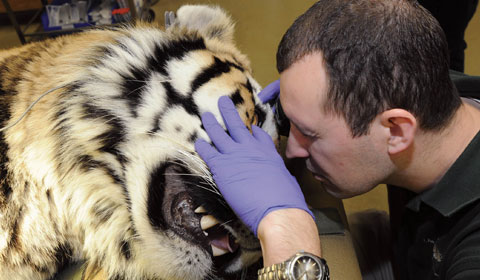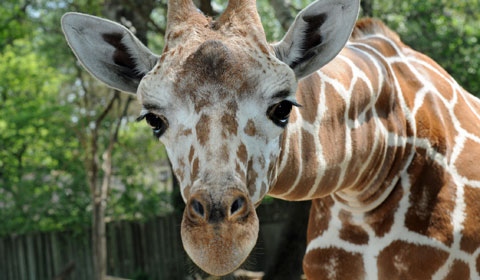News Release
Contact: Sondra Katzen, Public Relations, 708.688.8351,
sondra.katzen@czs.org
March 23, 2022
FOR IMMEDIATE RELEASE
Note: Scroll to end of press release to download photos of animatronics.
Ice Age Giants Opens April 1 at Brookfield Zoo
Temporary Exhibit Features more than 30 Animatronics
Brookfield, Ill. — A long, long time ago—2.6 million years to be exact—the Quaternary Ice Age began and continues today. However, it wasn’t until more recently—thousands of years ago—that entire species of enormous animals began to die off around the globe. Even though they are now extinct, guests can experience a time warp like no other and see what it was like to live among these megafauna from April 1 through October 30 at Brookfield Zoo’s temporary exhibit—Ice Age Giants, sponsored by Duly Health and Care.
Throughout the 216-acre park, guests will encounter more than 30 life-sized animatronic re-creations of giants that once roamed North America and Eurasia, including a 15-foot-tall woolly mammoth, an oafish 20-foot-long giant ground sloth, a 12-foot-tall giant bird, a fearsome 5-foot-long saber-toothed cat, and many more. Adding to the lifelike effects, parts of the animals such as the head, eyes, mouth, and tail move, making the experience even more realistic.
Youngsters can pretend to be an ice age giant and go inside the 5-foot-long Glyptodon Shell-ter—a great place for a photo op. This giant armored creature, who is a distant prehistoric relative of the modern-day armadillo, measured about 11 feet long from head to tail tip.
Along the pathways, as zoogoers travel back in time some 20,000 years ago during the peak of the Quaternary Period, colorful graphics present fascinating facts about each of the creatures such as where on Earth they once lived, how big they were, and how they compare to their modern relatives—many who are facing their own challenges to survive.
Additional illustrations present a timeline of Earth’s five significant ice ages—Huronian (2.4-2.1 billion years ago), Cryogenian (720-635 million years ago), Andean-Saharan (450-420 million years ago), Late Paleozoic (360-260 million years ago), and Quaternary (2.6 million years ago to present). Also, guests can learn about the theories as to why these behemoths went extinct, including overkilling, climate change, and disease. Even today, the same threats are impacting the survival of many animals like polar bears, Mexican wolves, North American river otters, and frogs, which can all be seen at Brookfield Zoo.
Admission to Brookfield Zoo, which includes access to Ice Age Giants, is $24.95 for adults, $17.95 for children ages 3-11 and $19.95 for seniors 65 and over. Parking is $15. The zoo is open daily from 10 a.m. to 5 p.m., with extended hours of 9:30 a.m. to 6 p.m. from Memorial Day to Labor Day. To learn more about the temporary exhibit before it goes extinct, visit CZS.org/IceAgeGiants.
# # #
Photo Captions--credit Cathy Bazzoni/CZS-Brookfield Zoo
16: Experts believe warming temperatures were the demise of the wonambi (pronounced woe-NAM-bee), a giant constrictor that measured between 16 and 20 feet long. Around the world, modern reptiles face similar threats.
21: The South American macrauchenia (pronounced mac-rah-KEY-nee-uh) were driven to extinction by migrating species from North America. Fossil evidence suggests newcomers quickly ate the available food and left the macrauchenia hungry and vulnerable to predators. Genetic evidence suggests the macrauchenia was related to modern tapirs, rhinos, and horses.
36: The massive mastodon (pronounced MAS-tuh-dawn), which weighed up to 17,000 pounds, neared extinction about 10,000 years ago. Evidence suggests that diminishing food sources—shrubbery and leaves—due to warming temperatures, made it impossible for the massive animal to survive.
41: Approximately 11,700 years ago, the last teratornis (pronounced ter-run-TOR-nis) soared through the sky. This raptor-like bird with a wingspan between 10½ and 12½ feet wide, needed to fly for extended periods in search of food. Increasing temperatures forced some of the bird’s favorite aquatic foods into deeper waters, forcing the hungry flying giant to search for food on land. However, once that happened, the teratornis was hunted by humans.
42: The castoroides (pronounced cast-ah-ROY-dez), which measured up to 7½ feet long and could weigh up to 300 pounds, resembled a giant beaver. Across the Midwest, rising temperatures caused struggling plants to adapt. As a result, the castoroides’ normal food source no longer contained enough nutrients to keep its massive body going. Without adequate food sources, the species went extinct about 11,500 years ago.
45: The smilodon (pronounced SMI-luh-dawn), a saber-toothed cat, pounced to extinction almost 10,000 years ago most likely due to changing climate and the arrival of early humans. Famous for its 11-inch incisors and mouth that opened nearly 180 degrees, this fearsome cat experienced competition for food from humans hunting in their habitat.
About the Chicago Zoological Society
The mission of the Chicago Zoological Society is to inspire conservation leadership by engaging people and communities with wildlife and nature. The Chicago Zoological Society is a private nonprofit organization that operates Brookfield Zoo on land owned by the Forest Preserves of Cook County. The Society is known throughout the world for its international role in animal population management and wildlife conservation. Its Center for the Science of Animal Care and Welfare is at the forefront of animal care that strives to discover and implement innovative approaches to zoo animal management. Brookfield Zoo is the first zoo in the world to be awarded the Humane Certified™ certification mark for the care and welfare of its animals, meeting American Humane Association’s rigorous certification standards. The zoo is located at 8400 31st Street in Brookfield, Illinois, between the Stevenson (I-55) and Eisenhower (I-290) expressways and also is accessible via the Tri-State Tollway (I-294), Metra commuter line, and CTA and PACE bus service. For further information, visit
CZS.org.
MEDIA CONTACT:
Sondra Katzen
Media Relations Manager
Office: 708-688-8351
Cell Phone: 708-903-2071
E-mail: Sondra.Katzen@CZS.org

Read about our innovative practices in animal welfare to ensure the ultimate care of our individual animals.

Create extraordinary connections with animals and nature!

Become our partner in caring for animals and in connecting people with wildlife and nature.